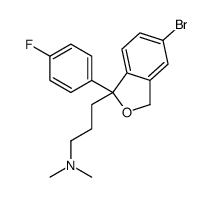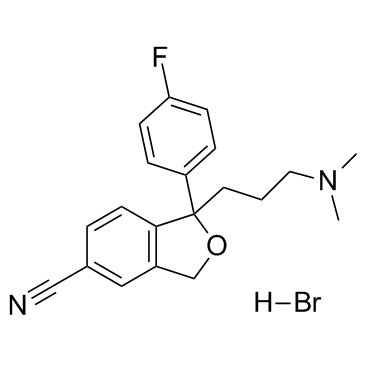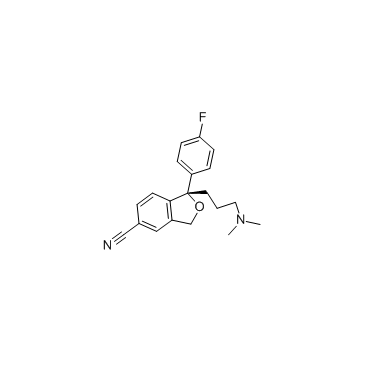59729-33-8
| Name | 1-[3-(dimethylamino)propyl]-1-(4-fluorophenyl)-1,3-dihydro-2-benzofuran-5-carbonitrile |
|---|---|
| Synonyms |
1-[3-(Dimethylamino)propyl]-1-(4-fluorophenyl)-5-phthalancarbonitrile
5-isobenzofurancarbonitrile, 1-3-(dimethylamino)propyl-1-(4-fluorophenyl)-1,3-dihydro- Cipram Nitalapram 1-[3-(Dimethylamino)propyl]-1-(4-fluorophenyl)-1,3-dihydro-5-isobenzofurancarbonitrile Citalec Citalopram Lexapro 1-[3-(Dimethylamino)propyl]-1-(4-fluorophenyl)-1,3-dihydro-2-benzofuran-5-carbonitrile 1-[3-(dimethylamino)propyl]-1-(4-fluorophenyl)-3H-2-benzofuran-5-carbonitrile Celexa 5-Isobenzofurancarbonitrile, 1-[3-(dimethylamino)propyl]-1-(4-fluorophenyl)-1,3-dihydro- 1-3-(dimethylamino)propyl-1-(4-fluorophenyl)-1,3-dihydro-2-benzofuran-5-carbonitrile MFCD00865398 Citabax Citalopramum Ciprapine Celapram Citopam EINECS 261-891-1 |
| Description | Citalopram is marketed as a racemate mixture of the S(+)-enantiomer and R(-)-enantiomer and the active S(+)-enantiomer (Escitalopram) that possess inhibitory effects. Citalopram is an antidepressant and enhances serotoninergic neurotransmission through potent and selective inhibition of serotonin reuptake (selective serotonin reuptake inhibitor)[1][2]. |
|---|---|
| Related Catalog | |
| References |
| Density | 1.2±0.1 g/cm3 |
|---|---|
| Boiling Point | 428.3±45.0 °C at 760 mmHg |
| Melting Point | 180 - 187ºC |
| Molecular Formula | C20H21FN2O |
| Molecular Weight | 324.392 |
| Flash Point | 212.8±28.7 °C |
| Exact Mass | 324.163788 |
| PSA | 36.26000 |
| LogP | 2.51 |
| Vapour Pressure | 0.0±1.0 mmHg at 25°C |
| Index of Refraction | 1.591 |
| Storage condition | Store at RT |
CHEMICAL IDENTIFICATION
HEALTH HAZARD DATAACUTE TOXICITY DATA
|
| Hazard Codes | Xi |
|---|---|
| RIDADR | 3249 |
| Packaging Group | III |
| Hazard Class | 6.1(b) |
| Precursor 9 | |
|---|---|
| DownStream 4 | |


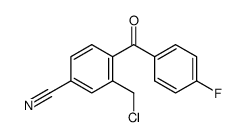


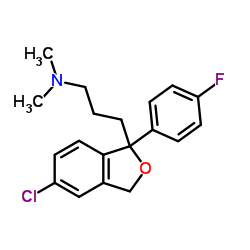
![1-[3-(Dimethylamino)propyl]-1-(4-fluorophenyl)-1,3-dihydro-5-isobenzofurancarboxamide structure](https://image.chemsrc.com/caspic/082/64372-56-1.png)
